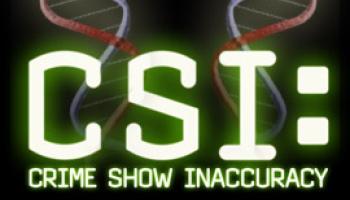Archival Notice
This is an archive page that is no longer being updated. It may contain outdated information and links may no longer function as originally intended.
Home | Glossary | Resources | Help | Contact Us | Course Map
With the increase in both fact based and fictionalized forensic programming, prosecutors are experiencing what has been coined the "CSI effect" when trying their cases. It has been estimated that over 12 million television viewers watch the original CSI: Crime Scene Investigation (Las Vegas) program. The success of this genre of television entertainment has spawned a plethora of similar forensic-based programs such as CSI Miami and CSI NY, Forensic Files, NCIS (with a Navy forensic focus), Without a Trace, Cold Case, and the entire Law and Order series. Jurors come to the courtroom with preconceived notions regarding law enforcement's use of high-tech instruments and the expectations that DNA is present and therefore should be collected in every case. Jurors do not realize the many factors that may have an impact on the feasibility of collecting DNA: the type of crime being prosecuted; the financial resources available to the prosecuting office; the typing laboratory's ability to test certain evidence, including whether it has certain technology available to it; any backlog issues that may be affecting the crime lab; or, whether the evidence was just not tested because it was not relevant to the case being prosecuted.
The prosecutor should determine which potential jurors believe criminal cases are always investigated as they are portrayed in CSI-like television programs. Prosecutors should educate jurors in voir dire and openings as to the differences between forensic and crime drama programs and the everyday workings of the real criminal justice system. Prosecutors should anticipate jurors' expectations regarding DNA evidence. For example, a prosecutor may call a scientific witness to explain why it would not be reasonable to obtain DNA evidence in a particular case. If jurors hear this information from a qualified forensic scientist, they may be less likely to improperly weigh the absence of evidence, or be misled by the defense argument that because forensic evidence was not found or presented, it must be because no crime was committed.
Prosecutors should not be too quick to dismiss all CSI watchers as potential jurors. CSI type programs do present DNA as incontrovertible evidence that is able to identify a suspect beyond a reasonable doubt. A CSI watcher may be an ideal juror in a case that turns on DNA evidence. If, however, the case rests on ID testimony with DNA simply used to corroborate a chain of events, then prosecutors should take care in seating a CSI watcher as a juror.
Additional Online Courses
- What Every First Responding Officer Should Know About DNA Evidence
- Collecting DNA Evidence at Property Crime Scenes
- DNA – A Prosecutor’s Practice Notebook
- Crime Scene and DNA Basics
- Laboratory Safety Programs
- DNA Amplification
- Population Genetics and Statistics
- Non-STR DNA Markers: SNPs, Y-STRs, LCN and mtDNA
- Firearms Examiner Training
- Forensic DNA Education for Law Enforcement Decisionmakers
- What Every Investigator and Evidence Technician Should Know About DNA Evidence
- Principles of Forensic DNA for Officers of the Court
- Law 101: Legal Guide for the Forensic Expert
- Laboratory Orientation and Testing of Body Fluids and Tissues
- DNA Extraction and Quantitation
- STR Data Analysis and Interpretation
- Communication Skills, Report Writing, and Courtroom Testimony
- Español for Law Enforcement
- Amplified DNA Product Separation for Forensic Analysts



